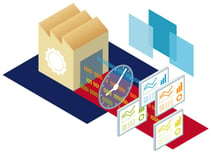5 Ways to Measure Supply Chain Visibility
Brian Hoey - July 03, 2018

Today’s supply chain managers are often in pursuit of that elusive measure of supply chain health: end-to-end (E2E) visibility. But how do you determine your business's existing level of visibility compared to the level that would best support its particular needs? Just as attaining a high degree of visibility can be a significant operational challenge, measuring visibility can be somewhat of a hurdle in its own right. To the end of helping you clear that hurdle, here are five strategies for ascertaining your level of supply chain visibility.
1. Checking for Silos
Because visibility is more of an abstract concept than, say, makespan or time to delivery, many of the metrics under discussion will require a minimum of number crunching relative to the amount of simple, descriptive information on the state of your value stream. To that end, the first and perhaps the most straightforward test for the state of you supply chain visibility is to search for information and decision-making silos. Pick a few pieces of operational data at random and see how easy or difficult it is for you to access that data. Not only will this give you insight into data accessibility, it will give you a sense of how well your various IT components are integrated with one another. If, for instance, you’ve adopted a postmodern ERP mindset, a simple check for information silos will help you determine whether or not you are successfully integrating all of the disparate solutions across your value chain.
2. Supply Chain Integration
Once you’ve ascertained the ease of finding any given piece of information, whether it be particular customer data or insight into operational decision-making processes, it’s time to perform the same operation outside of your own organizational infrastructure. Assuming your supply stream is fairly digitized, trying to access information from your suppliers can give you a good sense of how successful your efforts at supply chain integration have been. By the same token, you might look outside the office and onto the factory floor. Are your sensors and internet of things (IoT) devices capturing data that is accessible to those who might benefit from it? If you’re striving towards Industry 4.0 integration, have you succeeded in creating a digital version of your factory? How closely does it model the behavior of the real thing?
3. Forecast Error
Up till this point we’ve been relying on fairly subjective measures, like how easy or difficult it is to acquire a given piece of information. For a more objective approach to measuring your visibility, you might perform a deep dive into your forecast accuracy. Of course, all forecasts are, by nature, prone to inaccuracy, but consistent forecast errors can be a sign of a larger lack of transparency. When planners are unable to gain a cohesive picture of the entire value chain, their predictions will fail to account for numerous important factors, resulting in skewed results. Compare previous demand, shipping, and other forecasts to what actually took place and ask yourself a few questions: what percentage difference was there between your predictions and reality? When a prediction was inaccurate, was it due to an unforeseen supply chain disruption (like a natural disaster or trade dispute), or was there no discreet event that caused the difference? Are your forecasts all off in the same direction, i.e. consistently over or underestimating demand? The answers to these questions can begin to give you a more quantitative picture of any transparency issues within your value chain, offering you the opportunity to identify problem areas and test the efficacy of whatever solutions you implement.
4. Analytics Integration
This next measure may not be something that most companies would consider utilizing solely for the sake of measuring visibility, but that doesn’t mean that it’s any less informative than previous approaches. Essentially, different analytics processes require different degrees of visibility. Descriptive analytics require only enough visibility to determine what, exactly, occurred in a given situation, while diagnostic analytics necessitate a slightly higher degree of visibility in order to produce potential diagnoses for disruptions or breakdowns. By the same token, predictive and prescriptive analytics (i.e. advanced analytics) require even more access to data from within and without an organization, meaning that visibility must be much higher in order to support it. For businesses that are already interested in integrating analytics into their supply chain, these measures of visibility will come in the form of hurdles to be overcome and challenges to be met.
5. Developing KPIs
As you’ve gone through this post, you’ve probably noticed that none of the visibility tests presented above come with a thoroughly quantified scale or rubric. It would be difficult to distill any of these measurements into a single, representative number, which says something about the nature of supply chain visibility as a concept. That said, statistics and KPIs are still important to task of measuring your visibility. While visibility itself isn’t always something to which you can assign a number, most business goals are—and by trying to determine those numbers, you can simultaneously gain a more accurate picture of your current level of transparency. Choose one or more unrelated business goals with relevant KPIs, and try to measure those KPIs with whatever information is at your disposal. If you can make calculations and create hard numbers fairly easily, then your supply chain is probably healthy from a visibility perspective. If not, you may be suffering from information silos, Shadow IT, or other roadblocks to a transparent, connected value chain.
If you want to learn more get your Guide to Industry 4.0:
LATEST POSTS
- Understand Circular Economy in The Manufacturing Industry
- How Can Industry 4.0 IT Integration Be Achieved Smoothly?
- The Significance of Order Sequencing in Discrete Manufacturing
- How to improve your Supply Chain Management: The Power of Control Towers
- Optimizing Human Resource Scheduling in Manufacturing: A Technological Approach



